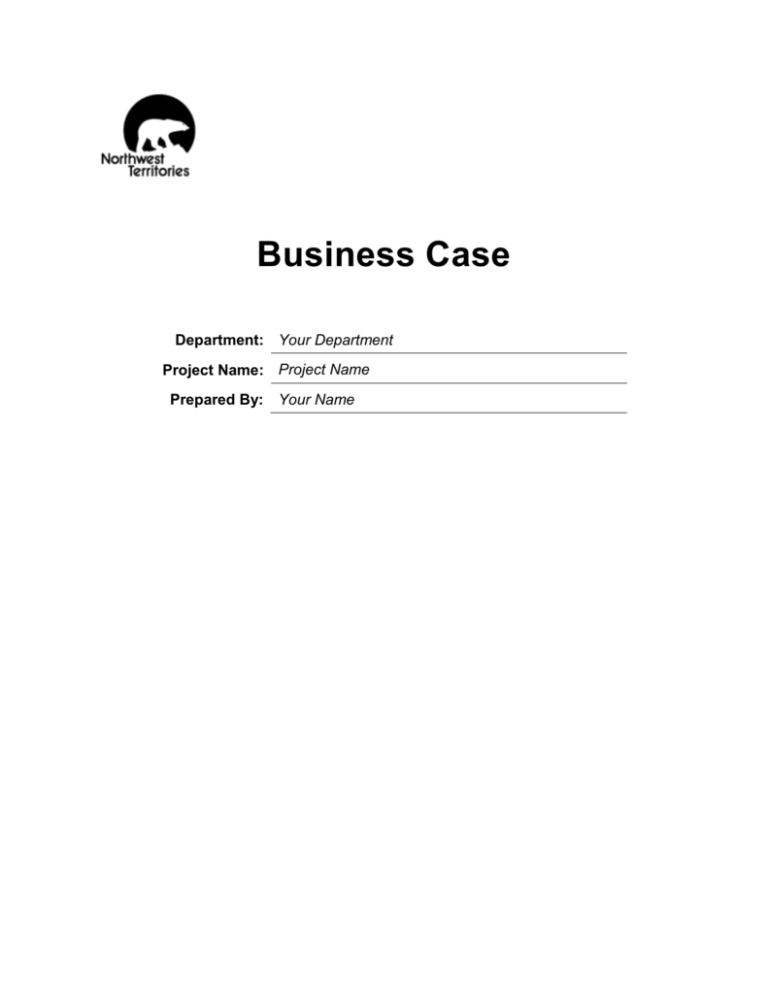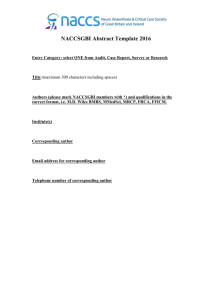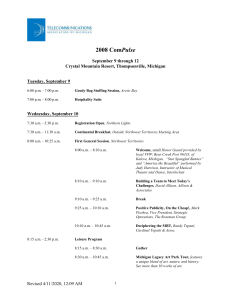Business Case - Department of Finance
advertisement

Business Case Department: Your Department Project Name: Project Name Prepared By: Your Name Table of Contents Introduction ................................................................................................................................ 1 Using this Template ................................................................................................................ 1 Authority Signatures .................................................................................................................. 2 Executive Summary ................................................................................................................... 3 Financial Summary .................................................................................................................... 4 Investment Profile ...................................................................................................................... 5 Business Needs and Desired Outcomes ................................................................................ 6 1.1 Strategic Environment ...................................................................................................... 6 1.2 Strategic Fit ...................................................................................................................... 7 1.3 Detailed Description of the Business Need ...................................................................... 7 1.4 Scope ............................................................................................................................... 7 Preliminary Options Analysis .................................................................................................. 9 2.1 2.1 Evaluation Criteria ...................................................................................................... 9 2.2 List the Possible Options .................................................................................................. 9 2.3 Screening of Options ........................................................................................................ 9 2.4 Rationale for Discounted and Viable Options ................................................................... 9 Viable Options ...................................................................................................................... 11 3.1 Alignment ....................................................................................................................... 11 3.2 Costs .............................................................................................................................. 11 3.3 Cost-Benefit Analysis ..................................................................................................... 11 3.4 Implementation and Capacity Considerations of Viable Options .................................... 11 3.5 Risk ................................................................................................................................ 12 3.6 Benchmark ..................................................................................................................... 12 3.7 Policy and Standard Considerations............................................................................... 12 3.8 Advantages and Disadvantages ..................................................................................... 12 Justification and Recommendation ....................................................................................... 14 4.1 Comparison Summary .................................................................................................... 14 4.2 The Preferred Option ...................................................................................................... 14 Managing the Investment ..................................................................................................... 16 5.1 Governance and Oversight ............................................................................................. 16 5.2 Project Management Strategy ........................................................................................ 16 5.3 Risk Management Strategy ............................................................................................ 16 5.4 Change Management Strategy ....................................................................................... 16 Glossary of Acronyms and Terms ........................................................................................... 19 Business Case | Project Name Introduction This document is your template for producing a business case. A business case is typically a presentation or a proposal to an authority by an organization seeking funding, approval, or both for an activity, initiative, or project. Using this Template To create a business case from this template, simply do the following: 1. Delete this page. 2. Fill in the blanks on the front page. 3. Replace the [bracketed text] in the document header with your project name and delete the brackets. 4. Save your document with a file name of your choice. 5. Complete the entire template. Each section contains brief instructions, shown in italics, which can be removed once your document is finalized. 6. Update the table of contents by right-clicking and selecting Update Field, then Update entire table. This template is adapted from the Government of Canada’s Business Case template. Consult the federal Treasury Board Secretariat’s Business Case Guide if you would like more information about a particular section of the business case or information about a business case in general. 1 Business Case | Project Name Authority Signatures These are the required signatures for capital projects. For non-capital projects, adjust the signature blocks to meet the authorization needs of the project. Business Sponsor Departmental CIO or ICT Director Director of TSC Name/Title: Type name and job title Signature: _______________________ Date: _____________ Signature: _______________________ Date: _____________ The Technology Service Centre has been fully informed and involved in the project being proposed to determine the infrastructure component requirements and associated cost estimates for the proposed project: Signature: _______________________ Director of Finance & Administration Departmental Financial Certification I have been informed of and involved in the proposed project and have determined: Regarding compliance with FAM 1601 and 1604, the Comptroller General has been fully informed and involved in the project being proposed to determine whether or not there is an accounting component contained within the proposed project. The one-time and ongoing O&M requirements of the proposed project have been understood and are supported by the department. Signature: _______________________ Comptroller General Deputy Minister Date: _____________ Date: _____________ Comptroller General Certification I have been informed of and involved in the proposed project and have determined: There is no accounting component and therefore no further involvement is required in the development of this project other than as required under FAM 2210 – Tangible Capital Assets – Information Systems. There is an accounting component and that: At this time it is not deemed feasible to utilize SAM for the identified financial processing requirements. I therefore approve submission of this project for consideration by IPC for the current business planning cycle. The proposed development scope includes components to integrate or interface with SAM and includes appropriate estimates for doing so. I therefore approve submission of this project for consideration by IPC for the current business planning cycle. Signature: _______________________ Date: _____________ Signature: _______________________ Date: _____________ Government of the Northwest Territories 2016 2 Business Case | Project Name Executive Summary Provide an executive summary (high level) that captures only the essential elements of the business case being presented. Include the business case’s most pertinent facts in a clear, concise, and strategic overview. This will be used as a summary of the project to the Business Advisory Committee, the Informatics Policy Council and the Financial Management Board. Ideally, the summary should be no more than half of a page. Checklist The pertinent facts of the business case are provided in a clear and concise fashion. Government of the Northwest Territories 2016 3 Business Case | Project Name Financial Summary If using this business case to apply for capital funding, complete the following financial summary to facilitate review and approval. The project costing sections of the business case should elaborate on the different types of funding needed, the major cost centres, one-time versus ongoing costs, demand on internal resources, and so on. This section merely clarifies what is being requested from the capital fund over the next 3 years. For non-capital projects, this page can be adapted or removed. One-Time Costs (in $000’s) Budget Year (2016/17) Year 2 (2017/18) Year 3 (2018/19) 3-Year Total Departmental Costs Capital 0 One-Time O&M 0 Total Dept. Costs 0 0 0 0 TSC Capital Costs Servers 0 Storage 0 Network 0 Total TSC Capital Costs 0 0 0 0 Total GNWT Costs 0 0 0 0 Contributions (3rd Party) Total One-Time Costs 0 0 Government of the Northwest Territories 2016 0 0 0 4 Business Case | Project Name Investment Profile The money spent on capital projects is categorized according to an investment profile, which is determined for each project under consideration. The profile used has three categories and the percentage of the investment is allocated for each category. Percentages of 0-100% are acceptable. The three allocations must add up to 100%. The three categories are: 1. Program Enhancement – The purpose of the project is primarily to enhance a government program in a way that provides increased value to the governments clients (residents or businesses) (e.g. faster service delivery) 2. Operational Excellence – The purpose of the project is primarily to enhance the operations of the government in a way that does not provide direct value to the government’s clients (e.g. reducing manual labour) 3. Risk Management – The purpose of the project is to mitigate or avoid some risk. (e.g. regulatory compliance, conformance to audit requirements, replace of high-risk systems) To assist the Project Management Office in categorizing the project’s investment profile, we are asking for a self-assessment from departments. This applies primarily to capital projects. Category Program Enhancement Operational Excellence Risk Management Allocated % % % % Government of the Northwest Territories 2016 Rationale 5 Business Case | Project Name Phase 1: The Strategic Context The Business Case has three phases, corresponding to Gates 1, 2 and 3 of the Systems Implementation Methodology. Complete Phase 1 of the Business Case as an input to Gate 1 – Concept. In Phase 1, you will document the business need, outcome and strategic alignment of the project. The audience is Deputy Ministers and senior decision makers. Business Needs and Desired Outcomes Complete the following sections to identify the need (problem or opportunity) facing the sponsoring organization and the desired business outcomes. 1.1 Strategic Environment 1.1.1 Organizational Overview To build a strong rationale for a proposed investment, the current environment needs to be described. The organizational overview of the sponsoring department, agency, or entity should include: - Mission - Strategic vision, goals, and service objectives - Current activities and services, including key stakeholders and clients - Organizational structure (high level) - Existing capacity - financial and human resources 1.1.2 Business Need This subsection contains a clear articulation of the business need in the form of a wellstructured statement that addresses the problem or opportunity. This statement should be no more than one or two sentences. 1.1.3 Drivers for Change Identify the drivers that have triggered the investment proposal. Both internal and external drivers of change should be identified and clearly linked to the business need. See typical drivers for change in the Business Case Guide. 1.1.4 Business Outcomes Describe the business outcomes (high level). A business outcome is the expected result or benefit that the organization is striving to achieve at the end of an intervention or change. Government of the Northwest Territories 2016 6 Business Case | Project Name 1.2 Strategic Fit To make a robust case for change, the business case should demonstrate how the proposed investment fits within the organization’s broader strategic context and contributes toward its goals and objectives. This subsection maps the investment proposal to the organizational framework. 1.3 Detailed Description of the Business Need 1.3.1 Problem/Opportunity Statement Reiterate the Business Need subsection’s well-structured statement that addressed the problem or opportunity. Along with the problem/opportunity statement, the following elements contribute to the detailed description of the business need. 1.3.2 Prioritized Requirements (High Level) Specify the key requirements to fully address the business need. Though the requirements are simply an elaboration of the business need, keep to a reasonable level of detail that allows for their comparison against the options. See example tables in the Business Case Guide. 1.3.3 Assumptions List and describe all the assumptions associated with the ability to address the key requirements—and the potential impact of those assumptions if they are not addressed. See example table in the Business Case Guide. 1.3.4 Constraints List and describe the specific constraints that place limits or conditions on the investment. They can come from external or internal factors. See example tables in the Business Case Guide. 1.3.5 Dependencies Identify dependencies related to the overall business need, requirements, or solution. See example table in the Business Case Guide. 1.4 Scope 1.4.1 Boundaries Identify what is to be included within the scope of the investment and explicitly state what is excluded from the investment. Government of the Northwest Territories 2016 7 Business Case | Project Name See example table in the Business Case Guide. 1.4.2 Stakeholder Analysis Describe the stakeholder environment by considering the types of stakeholders, their specific roles, and their contributions to the realization of the investment. See stakeholder examples in the Business Case Guide. Business Needs and Desired Outcomes Summary The case for change is established and the need for investment is clearly defined. Phase 1 Checklist The following questions are answered: Where are we now? – by describing the current business environment Where do we want to be? – by describing the business objectives What is the business need? – by describing the problem or opportunity facing the organization and the associated proposed investment What has triggered the need for change? – by describing the drivers for change What are we trying to achieve? – by describing the business’ desired outcomes What is the strategic fit? – by describing how the proposed investment maps to the departmental framework, to its goals, priorities, outcomes, and policies, as well as to those of the government Government of the Northwest Territories 2016 8 Business Case | Project Name Phase 2: Analysis and Recommendation Phase 2 (sections 2-4) are necessary to pass Gate 2 – Approach. In these sections, you will document the various options under consideration (sections 2-3) and the one selected for implementation (section 4). The main audience is senior decision makers (ADM level), Chief Information Officers and the Project Management Office. Preliminary Options Analysis Complete the following sections to screen a comprehensive list of options and narrow the field of alternatives down to a reasonable number of viable options. 2.1 2.1 Evaluation Criteria Define the evaluation criteria that will be used for screening and analysis of the options and will ultimately determine an overall recommendation. See evaluation criteria types (deal breakers, minimum requirement, and non-essential) and example table in the Business Case Guide. 2.2 List the Possible Options Identify, describe, and explore every possible option that can address the business need. The list should demonstrate due diligence in exploring options. See categories and example table in the Business Case Guide. 2.2.1 The Status Quo Include the status quo option (also known as the base case) as it will act as the baseline for the upcoming analysis. 2.2.2 Describing the Option Describe each preliminary option (high level). See example table in the Business Case Guide. 2.3 Screening of Options Assess how well each option meets the screening criteria. Determine whether a particular option should be discounted immediately or considered for further analysis as a viable option. See example table in the Business Case Guide. 2.4 Rationale for Discounted and Viable Options Develop the short list of viable options based on the assessment conducted in the screening of options and provide the reasons for retaining or discarding each option. See example table in the Business Case Guide. Government of the Northwest Territories 2016 9 Business Case | Project Name Preliminary Options Analysis Summary The identification, analysis, and screening of a comprehensive list of options to demonstrate due diligence in their selection has been completed. Government of the Northwest Territories 2016 10 Business Case | Project Name Viable Options 3.1 Alignment 3.1.1 Strategic Alignment Describe how the option supports the organization’s current business architecture and planned program results and strategic outcomes (if applicable). 3.1.2 Alignment with Desired Business Outcomes Prepare an option outcome analysis and present a summary of the findings for each business outcome. It may be preferable to organize the findings in a table format. See example table in the Business Case Guide. 3.2 Costs Provide a complete description of the costs. Projected costing estimates should be based on total cost of ownership, which includes ongoing costs over the course of the investment’s life cycle as well as potential compliance costs for stakeholder groups. See information on the Guide to Costing in the Business Case Guide. 3.3 Cost-Benefit Analysis Based on the costs established for each option, describe how those costs are weighed against the benefits. Conduct the cost-benefit analysis for each option taking into account costs, benefits, and risks. See information on the Canadian Cost-Benefit Analysis Guide and example tables in the Business Case Guide. 3.4 Implementation and Capacity Considerations of Viable Options Demonstrate the ability of the sponsoring organization to both deliver and manage the investment throughout its life span. 3.4.1 Contracting and Procurement Provide information concerning the procurement vehicle, and precisely how it will be utilized. 3.4.2 Schedule and Approach Identify the core work streams and associated milestones. 3.4.3 Impact Conduct an impact assessment from both internal and external perspectives. See example table in the Business Case Guide. Government of the Northwest Territories 2016 11 Business Case | Project Name 3.4.4 Capacity Describe the sponsoring organization’s capability to successfully manage the investment. See example table in the Business Case Guide. 3.5 Risk Identify the risks and conduct a risk assessment for each option, along with the development of a risk response. A useful tool for assessing the risk and complexity of a project is the GNWT Project Complexity and Risk Assessment (PCRA). 3.5.1 Option Risk Summary Describe the various attributes of each risk. Provide an option risk summary, which should include risk, probability, impact, mitigation and contingency, outcome, tolerance, and a risk assessment summary rating. It may be preferable to present the option risk summary for each option in a table format. See example table in the Business Case Guide. 3.5.2 Risk Register If an outcome management risk register has already been completed, its results can provide very useful input to the risk management section of the business case. See example risk register in the Business Case Guide. 3.6 Benchmark Compare each option against industry-standard benchmarks. Unavailability of benchmarking information for a specific option should be stated within the analysis. 3.7 Policy and Standard Considerations Describe the option’s impact, if any, on the existing policies and standards of the sponsoring organization and relevant stakeholder environments. Also describe any limitations imposed by the policies and standards and the known effect on the option. See example table in the Business Case Guide. 3.8 Advantages and Disadvantages Determine whether the option’s measure against the aforementioned criteria is found to be either an advantage or a disadvantage (financial and non-financial). It may be preferable to summarize the findings in a table format. See example table in the Business Case Guide. Viable Options Summary Government of the Northwest Territories 2016 12 Business Case | Project Name Building on the preliminary analysis of options, each viable option is subjected to an increasing level of rigorous analysis. Government of the Northwest Territories 2016 13 Business Case | Project Name Justification and Recommendation 4.1 Comparison Summary Present the viable options (including the status quo option used as the baseline) and compare them against a standardized set of criteria (financial and non-financial). It may be preferable to organize the comparison in a table format. See example table in the Business Case Guide. 4.2 The Preferred Option 4.2.1 Recommendation Present the recommendation in a straightforward manner, clearly stating why the organization will benefit by focussing its investment on one particular option. 4.2.2 Deciding Factors Identify the deciding factors (financial and strategic) for selecting the preferred option. See common and possible factors in the Business Case Guide. 4.2.3 Costs Provide a brief summary of the preferred option’s costing estimates and link them with the components of the work streams. See information on accrual accounting-based costs in the Business Case Guide. 4.2.4 Risks Illustrate why the identified risks are acceptable. Narrative may be included to further contextualize the key factors supporting the overall risk assessment, which include impact, probability, outcomes, and so forth. A useful tool is the GNWT Project Complexity and Risk Assessment. 4.2.5 Implementation Plan Outline how the project will be implemented. Provide an implementation plan (strategic work plan) to demonstrate that the proposed investment has been appropriately thought through and that the estimates presented are within an acceptable degree of accuracy. Justification and Recommendation Summary A full comparison of each viable option against the evaluation criteria has been completed and the case is made to recommend a preferred option based on its net advantages over all other viable options. Government of the Northwest Territories 2016 14 Business Case | Project Name Phase 2 Checklist The following questions are answered: How will we get there? – by presenting the viable options—and associated costs and benefits—for detailed analysis and assessing them against the evaluation criteria that is used to determine an overall recommendation What is the best option? – by making the case to recommend a preferred option based on its net advantages over all other viable options Government of the Northwest Territories 2016 15 Business Case | Project Name Phase 3: Management and Capacity Phase 3 is necessary to complete the business case and pass Gate 3 – Business Case. This section deals with the structures, resources and processes that will be put in place to ensure project success. The audience is the same as the last phase (ADMs, CIOs and the PMO). Managing the Investment Complete the following sections to describe, at a strategic level, how the investment will be managed. 5.1 Governance and Oversight Demonstrate where and how the proposed investment would fit within the organization’s broader governance and oversight structure. 5.2 Project Management Strategy Demonstrate that the organization has and will apply a sound methodology to manage the project during its life cycle and through post-implementation. 5.2.1 Project Review Strategy Provide an overview of the methods and processes that have been or will be implemented to gauge the project’s progress and how that progress will be communicated to the project team, project sponsor, and other stakeholders. 5.3 Risk Management Strategy Demonstrate that the organization has a function in place to manage the risks of the project. 5.4 Change Management Strategy Describe how the potential impact of the proposed change on organizational culture, systems, and processes and on people working within and with the invested organizations will be managed in later stages of the project management process. Managing the Investment Summary How the investment will be managed at the strategic level is described. Phase 3 Checklist The following questions are answered: Government of the Northwest Territories 2016 16 Business Case | Project Name Where and how will the investment fit within the organization’s broader governance and oversight structure? – by describing the governance and oversight strategy for the investment How will the project be managed and reviewed throughout its life cycle? – by describing the project management strategy for the investment How will the business outcomes be realized? – by describing the outcome management strategy for the investment How will the business risks be mitigated and managed? – by describing the risk management strategy for the investment How will change be managed and implemented? – by describing the change management strategy for the investment How will performance be measured? – by defining the project implementation and benefits realization performance measurement strategy Government of the Northwest Territories 2016 17 Business Case | Project Name Appendices Government of the Northwest Territories 2016 18 Business Case | Project Name Glossary of Acronyms and Terms Provide all acronyms in full and define all terms required to understand the business case properly. Acronym In Full Term Definition Government of the Northwest Territories 2016 19







